
The foreign exchange market, also known as the Forex market, is the largest and most liquid financial market in the world. Trillions of dollars are traded every day by individuals, banks, and corporations looking to buy and sell currencies from around the world. Central bank interest rate decisions are one of the most important factors that influence the Forex market. In this article, we will explore how Forex market reacts to central bank interest rate decisions.
The Relationship between Interest Rates and Forex Market
Interest rates play a critical role in determining the value of currencies in the Forex market. When a country’s central bank raises interest rates, it makes the currency more attractive to foreign investors, leading to an increase in demand and a rise in its value relative to other currencies. Conversely, when a central bank lowers interest rates, it makes the currency less attractive to foreign investors, leading to a decrease in demand and a fall in its value relative to other currencies.
Central bank interest rate are therefore closely watched by Forex traders as they directly impact the value of currency pairs. In addition, interest rate decisions can also have indirect effects on the Forex market by influencing other economic indicators such as inflation, employment, and GDP.
Factors Affecting Central Bank Interest Rate Decisions
Central bank interest rate are based on a variety of economic and political factors. Economic indicators such as inflation, employment, and GDP growth are closely monitored by central banks when making interest rate decisions. A high level of inflation, for example, may prompt a central bank to raise interest rates to curb inflationary pressures.
Political factors can also influence central bank interest rate decisions. For example, a government that wants to stimulate economic growth may pressure its central bank to lower interest rates to encourage borrowing and spending.
Forex Market Reaction to Central Bank Interest Rate Decisions
The Forex market reacts quickly and decisively to central bank interest rate decisions. When a central bank announces an interest rate, the immediate impact can be seen in the currency pairs affected by the decision. For example, if the US Federal Reserve raises interest rates, the US dollar will typically strengthen against other currencies, such as the euro, yen, or pound.
The short-term and long-term effects of interest rate decisions on the Forex market can vary. In the short-term, interest rate decisions can cause significant volatility, with large price swings and fluctuations in trading volume. In the long-term, the impact of interest rate decisions can be felt through changes in economic indicators, which can in turn influence currency values.
Examples of past reactions to interest rate include the Bank of Japan’s decision to introduce negative interest rates in 2016, which caused the yen to weaken against the dollar, and the European Central Bank’s decision to raise interest rates in 2011, which caused the euro to strengthen against the dollar.
Strategies for Trading During Central Bank Interest Rate
Trading during central bank interest rate requires a careful approach to minimize risk and take advantage of potential trading opportunities. Here are some best practices to consider:
-
Stay informed:
Keep up to date with the latest news and economic data releases that could influence central bank interest rate decisions.
-
Use stop-loss orders:
Place stop-loss orders to limit potential losses if the market moves against your position.
-
Monitor volatility:
Central bank interest rate can cause significant volatility, so it’s important to be aware of price fluctuations and changes in trading volume.
-
Analyze market sentiment:
Consider market sentiment and how other traders are reacting to the interest rate decision.
-
Have a trading plan:
Develop a trading plan that takes into account different scenarios and potential outcomes of the interest rate decision.
-
Consider trading opportunities:
Interest rate can create trading opportunities, such as buying or selling currency pairs that are likely to be affected by the decision.
-
Be patient:
Don’t rush into trades immediately after an interest rate decision is announced. Take time to analyze the market and wait for the initial volatility to subside before making a trade.
Conclusion
Central bank interest rate are a major factor in the Forex market, and can have significant short-term and long-term effects on currency values. Forex traders should stay informed about interest rate and use best practices to minimize risk and take advantage of potential trading opportunities. By following these strategies, traders can navigate the volatility of central bank interest rate and make informed trading decisions in the Forex market.
Related Post:
Forex Traders Brace for Volatility Ahead of Crucial Data Release on Interest Rates























